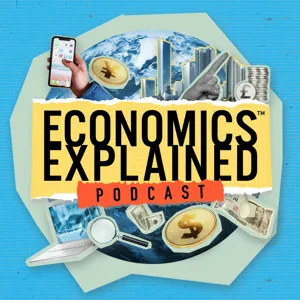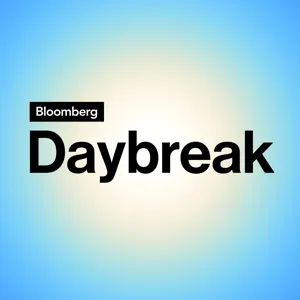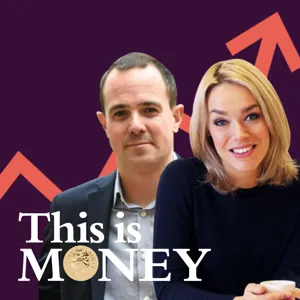Podcast Summary
US Inflation Hits 30-Year High: What Does it Mean?: The US is experiencing significant inflation, with the Federal Reserve responding by accelerating plans to cut off bond buying. The long-term implications for the economy and global markets are uncertain, emphasizing the importance of staying informed about economic variables.
The current inflation situation in the US is significant and complex, with potential far-reaching consequences for the economy and the world. Former Beijing bureau chief for The New York Times, Jane Perlez, discussed this topic on her new podcast, "Face Off: US versus China." According to Perlez, the Federal Reserve's recent shift in rhetoric regarding inflation and its plans to cut off bond buying faster than expected came as inflation reached its highest levels in over 30 years. While some economic experts predicted this outcome, the severity and potential long-term implications are still uncertain. Perlez emphasized the importance of understanding current economic variables to stay informed about policy decisions that will impact daily life. She also reminded listeners that no one can accurately predict the future, especially economists. The ongoing inflation problem raises questions about the Fed's ability to address it without negatively affecting the labor market and asset prices. Additionally, the potential consequences for the global economy are still unfolding. As we approach the end of 2021, it's crucial to stay informed about these developments and their potential impacts.
Learning economics through collaboration and critique: Engage in a peer-review process to deepen understanding of economic concepts and contribute to ongoing discourse.
No single source is infallible when it comes to understanding complex economic concepts. The creators of "Economics Explained" acknowledged their mistakes and invited viewers to help identify errors in their past videos in exchange for a chance to win a trip to Australia. This peer-review approach reflects the social science nature of economics, where rigorous examination and critique are essential for progress. The video also clarified the concepts of cost-push and demand-pull inflation, two types of inflation caused by changes in supply and demand, respectively. Cost-push inflation occurs when the cost of producing goods increases, leading to higher prices, while demand-pull inflation occurs when increased demand outstrips supply, resulting in price increases. By fostering a collaborative and critical learning environment, "Economics Explained" encourages viewers to deepen their understanding of economic concepts and contribute to the ongoing discourse.
Fed targets demand pull inflation for consumption, struggles with cost push inflation: The Fed aims for 2% demand pull inflation to boost consumption but faces challenges controlling cost push inflation, primarily caused by supply side issues.
While a little demand pull inflation can be beneficial for the economy, the Federal Reserve aims for a 2% rate to encourage consumption rather than hoarding. However, cost push inflation, which is driven by production issues and supply chain disruptions, is a different story. The Fed cannot directly address cost push inflation with monetary policy, making it a challenge to control. This year, most inflation has been due to cost push factors, particularly in items with sticky prices, such as new cars and certain consumer goods. Even companies with historically stable pricing, like Dollar Tree, have had to raise prices to remain profitable. The current inflation is primarily caused by supply side issues, and while the Fed's money printing has not been the sole cause, it may have contributed to the overall inflationary pressure.
Impact of Demand Pull Inflation not fully captured by CPI: The CPI underestimates inflation in assets like stocks and housing, as it doesn't account for investor demand and capital inflows.
While demand pull inflation has significantly impacted prices in certain markets, such as housing and stocks, it is not fully captured by the Consumer Price Index (CPI). The CPI primarily tracks consumer purchases, excluding markets like the stock market and housing. As a result, two major forces have been driving up stock prices: the lack of alternatives for investors and the abundance of capital flooding the markets. The Fed's bond buying program has put a lot of money into the hands of investors and businesses, leading to price inflation in various assets, including stocks, cryptocurrencies, and luxury goods. However, the most significant impact of inflation is felt in the housing market, where prices have increased dramatically due to cheap interest rates and investor demand. Despite housing being the largest expense for most families, its price is not directly included in the CPI, leading to a disconnect between the cost of living and the official inflation rate.
Economic shifts contributing to wealth inequality: Record-breaking stock market highs and retirements fueled by savings contribute to wealth inequality, especially in the housing market. The Federal Reserve's focus on low unemployment and stable prices requires careful management to prevent inflation.
While record-breaking stock market highs and retirements fueled by savings and market rallies may seem like positive developments for some, they also contribute to growing wealth inequality, particularly in the housing market. Meanwhile, the Federal Reserve's focus on maintaining low unemployment and stable prices creates a delicate balance that could lead to inflation if not managed carefully. The pandemic's impact on employment and savings has accelerated these trends, with some people retiring earlier than planned due to health concerns and economic uncertainty, while others have had to spend their savings or return to work as unemployment rates have rebounded. Overall, these economic shifts highlight the importance of addressing wealth inequality and ensuring that economic policies support broad-based prosperity.
Understanding the difference between employment and unemployment rates: The employment rate, which includes those retired or not in the labor force, has been declining due to demographic changes and longer education periods, but the pandemic caused a significant drop. The retirement of experienced workers poses a long-term challenge to productivity and addressing economic issues.
The employment rate and unemployment rate are two different measures of labor market health. While the unemployment rate focuses on those actively seeking employment, the employment rate includes not only the employed but also those who are retired, disabled, or otherwise not in the labor force. This rate has been declining for decades due to an aging population and longer periods of education, but the COVID-19 pandemic caused a significant drop in employment that has yet to fully recover. The retirement of experienced workers, particularly in developed service-based economies, may pose a long-term challenge as they leave the workforce and take their expertise and connections with them. This trend could impact productivity and the ability to address current economic issues. Despite the challenges, it's important to note that the current issue of businesses struggling to find entry-level employees might be a short-term problem that resolves itself over time. The bigger concern may be the retirement of experienced workers and the loss of their valuable skills and experience. This trend has been ongoing for decades but has been exacerbated by the pandemic and the resulting economic conditions that have made early retirement more attractive for some.
Fed's Inflation-Fighting Dilemma Amidst Labor Shortages and Pandemic: The Fed faces a delicate balance between controlling inflation and supporting economic recovery, considering the impact of labor shortages, low unemployment, and potential cost-push inflation.
The Federal Reserve is facing a challenging position due to labor shortages and high inflation caused by the ongoing pandemic. While low labor force participation and unemployment may lead to demand-pull inflation with higher wages, businesses running at less than full capacity could result in cost-push inflation. However, raising interest rates to combat inflation could negatively impact retirees and asset markets, slowing down the economic recovery. The Fed must balance its inflation-fighting responsibilities with the well-being of the people. The question remains, how severe will this inflation get? While the US dollar's status as the world reserve currency offers some protection, hyperinflation is still a possibility if inflation persists for an extended period. However, if inflation is only temporary, it could serve as a "catch-up period" for the Fed to gradually introduce higher interest rates without risking a deflationary spiral. Additionally, the popular "money printer meme" may be misleading, as the M1 money supply chart spike coincided with pandemic stimulus measures.
Fed's Decision Led to Nearly 50% Increase in Money Supply: The Fed's decision to include savings account money led to a significant increase in the money supply, but the long-term implications on our way of life are yet to be seen.
The significant increase in the money supply during the pandemic, as shown in the graph, was primarily due to the Federal Reserve's decision to include cash kept in savings accounts, not just money printed. This led to a nearly 50% increase in the total money supply since the start of the pandemic. However, it's important to note that this does not mean we should stop worrying. We are still dealing with the devastating effects of the pandemic, which has resulted in more American deaths than both world wars combined. The long-term implications on our way of life are yet to be seen. Printing more money while relying on fewer people to add value to the economy can only lead to one outcome. If you're interested in personal finance and want to make smarter decisions with your money, tune in to NerdWallet's Smart Money podcast. Our team of experts will help you navigate the world of credit cards, banking, investing, and more. Listen wherever you get your podcasts.






